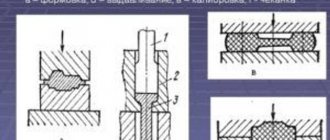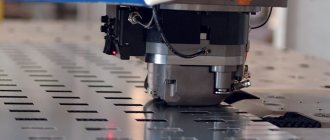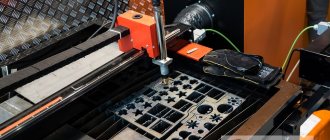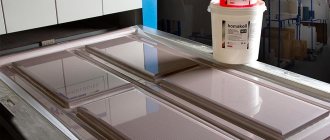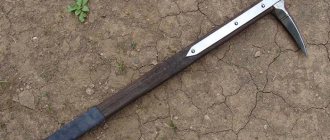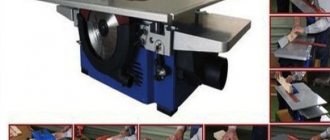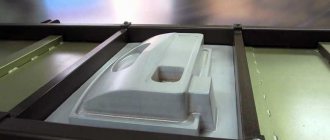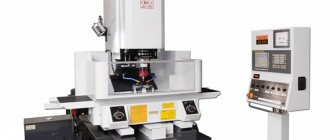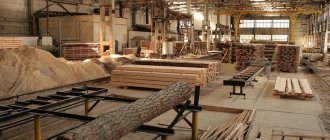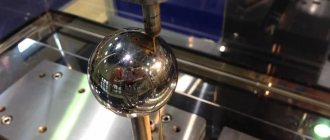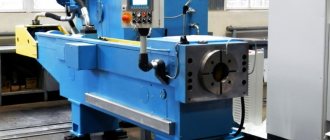A press brake is used to shape sheet metal products into a specific configuration. Models of the KRV series are distinguished by a progressive design with reinforced fins, which ensures stable bending quality. As a result, the equipment makes it possible to produce profiles of complex shapes used in mechanical engineering, the production of furniture, automotive components and precision instruments.
The machine differs from similar devices in its bending accuracy. The hydraulic press brake is selected based on the length of the bend line, the thickness of the material and the tensile strength of the material. The speed of work and the complexity of the profile obtained as a result of processing are also important.
Technical advantages
- E22 controller with a tooling library, thanks to which you can program the bending angle in degrees. The operator can change the angle manually precisely without additional calculations.
- A frame made of structural steel with low-temperature tempering, increased weight and improved torsional resistance is responsible for repeatability of bending and durability of the structure.
- Hydraulics EBM, Bosch Rexroth (Germany) or HUAYI (Spain).
- Electromechanical back stop with two stop fingers, manually adjustable.
- The front support calipers move along a linear guide.
- Four-sided multi-strand matrix over the entire working length.
II. Which press brake should you choose?
Traditional mechanical presses are used less and less and only for special stamping work on long workpieces.
In recent years, some manufacturers have also offered excellent electromechanical press brakes with multiple CNC controlled backgauge axes.
Among hydraulic presses, you can find a wide variety of models with one, two or even four cylinders, with a downward moving crossbar (“downstroke”) or an upward moving table (“upstroke”). We will focus on 2 groups of hydraulic press brakes that are most widely used throughout the world.
The contrast between them is obvious: on the one hand there are presses based on old but still good technology, on the other hand there are presses using the latest advances in technology.
The power of the market is great. Therefore, many manufacturers offer both groups of presses to meet customer needs.
Let's consider both groups:
Press brake with mechanical stop
Hydraulic press brakes with two cylinders on top (“down stroke”). Crossbar alignment is accomplished either hydraulically or mechanically using an appropriately sized torsion bar on the rear of the press. Two mechanical stops in the cylinders are adjusted manually or by actuator to the desired Y-axis position. This is technology that is at least 30 years old.
Simple numerical control helped this type of press to be in demand throughout the world, regardless of the level of industrial development of the country in question. The Y axis position for a specific angle is stored in memory and combined with the backgauge position (X axis) using a simple program. One or two bending angles per part. Why invest in complex machines when you can be sure that this type is sufficient for the bending needs of the present and future?
Do not forget
A large number of profiles can only be obtained with a special tool through calibration.
As we have seen, in such cases, the force and shape of the tool are important, and not the high accuracy of setting and repeating the Y axis (Y1-Y2) - the position of the traverse.
CNC press brake with servo-hydraulics
There is no doubt that the trend is moving towards CNC press brakes with servo-hydraulics, made according to the “down stroke” design.
The position of the traverse is controlled via a closed circuit. The cylinders operate synchronously with a high degree of precision. The position of the Y1 and Y2 axes is measured under each cylinder with an accuracy of 5 µm and transmitted to the CNC.
A CNC-controlled backgauge system is available for the following axes:
- XR
- X1-X2-R
- XR Z1-Z2
- X1-X2-R-Z1-Z2
- X1-X2-R1-R2-Z1-Z2
CNC
Delem and Cybelec are suppliers of graphical controls used by many press brake manufacturers. Some press manufacturers have developed their own CNC controls.
All of them are high-tech and available in 2D or 3D versions. They offer the optimal bending sequence, and you can simulate the entire bending process, check whether the part is touching parts of the press or tool, and calculate the length of the profile development.
Programming can be done on a machine in the shop or on a PC with CAM software, which is offered by all press manufacturers.
Special abilities
Most manufacturers take into account the special requirements of customers. For example, increased travel of the traverse, increased distance between the table and the traverse, increased depth of the throat, lateral extensions of the table and traverse, etc.
What does the control system provide?
A CNC-equipped hydraulic press brake offers the manufacturer unlimited functionality. Modern automation consists of controllers with two and three-dimensional visualization, due to which complex operations are performed for the production of non-trivial bent configurations. The device’s memory stores 30 programs with which you can process metal. But the main advantage of CNC is the precision bending of sheet material at high speed. The machines will be indispensable in large-scale enterprises.
Hydraulic press brakes
The production of three-dimensional parts from sheet blanks of various materials (different grades of steel, precious metals or non-ferrous alloys) requires special equipment that bends the sheet as accurately as possible. For these purposes, at the modern stage of production, bending press machines are used.
When choosing sheet bending equipment, you should be guided by the following characteristics:
- machine type;
- permissible thickness of the material to be processed;
- the maximum bending force that the device can provide;
- the size of the table with which the sheet bending machine is equipped (its working part);
- equipment performance;
- the availability of equipment that allows for the execution of bends of various shapes, and its diversity;
- availability of other special features.
Among various types of sheet benders, the most popular are hydraulic ones, which differ from manual and electromechanical devices in their high precision and the ability to process workpieces of greater thickness.
Presses equipped with a hydraulic drive are widely used in various industrial and repair shops to carry out single- or medium-batch production processes that do not require frequent reconfiguration of equipment.
Most often, presses are used, the drive of which operates on two or four hydraulic cylinders, which help lower the working traverse of the mechanism with a fixed punch. Such a press provides bending with a force of several thousand tons. Equipment setup operations are performed manually. Mechanically controlled sheet bending machines are inexpensive.
A CNC-equipped press brake is a more efficient and easy-to-use device. Equipment of this type is equipped with servo-hydraulics, which is controlled by a programmable controller. Servo valves ensure precise synchronization of hydraulic cylinders; their positioning accuracy is measured in microns.
The CNC module, using specially designed sensors, monitors information, helping to eliminate distortions of the punch, which allows you to achieve maximum accuracy in the manufacture of the product and durability of the equipment.
The programs allow you to control the following parameters:
- moving the traverse (raising or lowering it);
- setting the required bending force;
- adjusting the stops of the rear part of the device in order to fix the workpiece as accurately as possible, as well as the front supports that provide support;
- frequency of work cycles, etc.
Certain modifications of CNC-equipped presses can be customized using 2D or 3D models loaded with specialized drawing programs. In addition, special modules have been developed to equip bending presses, responsible for feeding metal sheets or workpieces.
Bending force developed by a hydraulically driven sheet metal bending machine
The force required to process (bend) a certain part is directly proportional to the bend length (L) and the square of the workpiece thickness (S2) and inversely proportional to the opening of the matrix (the maximum width of the groove on its reverse side, which has a triangular shape). To determine it, the formula is used:
Fbend = 1.42PTS2L/1000A,
where PT is the tensile strength of the material.
1.42 - coefficient taking into account the friction of the sheet on the edge of the matrix;
Pτ—tensile strength (kg/mm2);
S2 - square of metal thickness (mm2);
L—working length of bend (mm);
A is the maximum width of the triangular groove of the support side of the matrix (matrix opening, mm).
The press brake passport contains a table of bending forces for various materials. But equipment should be selected with a small margin, since its constant operation at maximum load is fraught with premature wear. And, conversely, an increased power reserve leads to a decrease in the response speed of hydraulic cylinders, and, consequently, to a decrease in equipment productivity. To choose a device that best suits the operating conditions, it is better to seek help from specialists.
Ab table size
The choice of device for this parameter depends on production needs (length of workpieces to be processed). Most often, sheet bending machines with a working table from 1 to 6 m are used.
Plate bending machine performance
The productivity of the press is calculated in the number of its working cycles per unit of time. It directly affects the cost of manufactured parts. The time spent bending a part also depends on the speed of reconfiguring the press to perform a particular operation.
To reduce the time allotted for setup, easily removable dies and punches are used, as well as simply adjustable back stops. Facilitates the setup of the machine by programming its operating modes. Working with box-shaped blanks involves changing the bending length, for which type-setting punches are used.
Press Brake Equipment
Each bending device is equipped with a set of dies and punches, the use of which ensures bending of different configurations.
For example, for “free bending” the workpiece being processed is not provided for contact with the V-shaped groove of the matrix, and the formation of the bending angle is carried out by the force of the punch. This method does not require frequent replacement of equipment and is often used in the manufacture of products on CNC-equipped presses.
When the highest possible accuracy is required, a calibration method is used that involves completely clamping the metal workpiece between the walls of the die and the punch. Various forms of dies and punches provide the ability to obtain products of the most complex configurations.
produces and sells a series of press brakes "LG". The choice of this equipment requires a thoughtful approach. The company's managers will help you select a device whose technical parameters fully comply with the requirements of a specific production. To buy a press brake from our company, just contact us, and we will select different options as soon as possible!
© IC "Stankosnab" - offers to buy inexpensive hydraulic press brakes.
